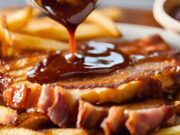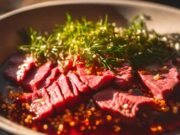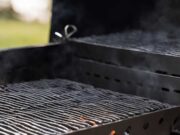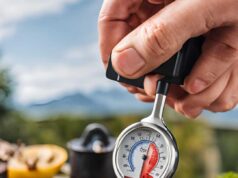- Key Takeaways:
- How to Use a Meat Thermometer: Ensuring Perfectly Cooked BBQ Every Time
- Why Use a Meat Thermometer
- Types of Meat Thermometers
- Proper Techniques for Using a Meat Thermometer
- Ideal Temperature Range for Different Meats
- Tips for Accurately and Efficiently Using a Meat Thermometer
- Common Mistakes to Avoid When Using a Meat Thermometer
- Final Thoughts
- Frequently Asked Questions
Cooking the perfect barbecue involves more than just selecting the right seasoning or timing; it requires achieving that ideal doneness, which can only be accurately assessed with a meat thermometer.
This essential tool ensures that your meats are cooked to perfection while also helping to prevent foodborne illnesses, thereby making your BBQ safer for all attendees.
This guide will explore the various types of meat thermometers, share techniques for accurate usage, and provide tips for avoiding common mistakes, ensuring that your grilling skills are consistently top-notch.
Key Takeaways:
- Use a meat thermometer to achieve perfectly cooked BBQ every time by ensuring doneness and preventing foodborne illnesses.
- Choose between instant-read or leave-in thermometers and learn proper techniques for insertion and monitoring cook time.
- Keep it germ-free, double check presets, and use multiple thermometers for large cuts to accurately and efficiently use a meat thermometer.
How to Use a Meat Thermometer: Ensuring Perfectly Cooked BBQ Every Time
Utilizing a meat thermometer is an essential technique for achieving perfectly cooked BBQ each time, ensuring that your favorite meats, such as beef, pork, and poultry, are grilled to perfection.
By accurately monitoring the internal temperature, you can prevent both undercooked and overcooked pieces, which can compromise the flavors and juiciness of your meal. A high-quality digital or instant-read meat thermometer enables you to check the doneness of various meats safely, providing you with peace of mind that you are serving your guests not only delicious but also safe food, free from harmful bacteria.
This guide will equip you with an understanding of the different types of thermometers, their usage, and tips for achieving optimal results.
Why Use a Meat Thermometer
Utilizing a meat thermometer is essential for ensuring that your meats reach the appropriate internal temperature, which guarantees proper doneness while preventing foodborne illnesses. This vital kitchen tool enables you to monitor the safety of your food, thereby reducing the risk of serving undercooked meat that may contain harmful bacteria.
By recognizing the significance of temperature accuracy, you can serve juicy, well-cooked dishes that retain their flavors and provide peace of mind for both you and your guests.
Ensures doneness
One of the primary reasons for utilizing a meat thermometer is to ensure that your meats are cooked to the desired doneness, which can vary based on the type of meat and individual preferences.
Achieving the correct internal temperature is essential not only for flavor but also for safety. For example, beef is typically considered medium-rare at an internal temperature of 130-135°F, providing a juicy, tender experience. In contrast, pork should reach a minimum of 145°F to eliminate any harmful bacteria while still retaining its succulent texture. Poultry, including chicken and turkey, requires an internal temperature of 165°F to ensure thorough cooking.
Techniques such as roasting, grilling, and sous-vide depend heavily on precise temperature readings to achieve optimal results and enhance flavors, enabling cooks to elevate their culinary skills with confidence.
Prevents foodborne illnesses
Using a meat thermometer can significantly reduce the risk of foodborne illnesses associated with undercooked meats, ensuring that harmful bacteria are effectively eliminated during the cooking process.
By accurately measuring the internal temperature, you can ensure that the meat has reached safe cooking levels. The USDA recommends specific minimum temperatures for various types of meat; for instance, poultry should reach at least 165°F, while ground beef should be cooked to a minimum of 160°F.
When handling meat, it is crucial to maintain proper hygiene practices, such as thoroughly washing your hands before and after touching any raw products. Utilizing separate cutting boards for raw meat and other food items can help prevent cross-contamination, further enhancing safety in the kitchen.
Adopting these measures can greatly contribute to safer meal preparations and healthier dining experiences.
Types of Meat Thermometers
Several types of meat thermometers are available on the market, including digital meat thermometers, instant-read thermometers, and leave-in thermometers, each serving a distinct purpose in the kitchen.
Digital thermometers offer quick and accurate readings, while instant-read options facilitate fast checks during the cooking process.
In contrast, leave-in thermometers monitor the internal temperature continuously, ensuring your meats are cooked to perfection without the need to open the grill or oven. Understanding the various types of thermometers will enable you to select the best one to meet your cooking needs.
Instant-Read Thermometers
Instant-read thermometers are designed for quick and accurate readings, allowing you to check the internal temperature of your meat in seconds.
Equipped with advanced technology, these tools enhance your cooking experience by ensuring that meat reaches the perfect doneness without any guesswork. Whether you are grilling steaks to a juicy medium-rare or roasting a chicken to a safe internal temperature, these thermometers become essential allies in your kitchen.

They excel in various situations—from weekday dinners to holiday feasts—ensuring that every dish is cooked to perfection. By using an instant-read thermometer, you can avoid the pitfalls of overcooking, which often leads to dry and less flavorful meals. This ultimately improves your overall cooking outcomes and helps you deliver delicious results every time.
Leave-In Thermometers
Leave-in thermometers are particularly beneficial for long-cooking methods, as they enable you to monitor the internal temperature of your meat without the need to open the grill or oven. This functionality helps maintain optimal cooking conditions while significantly reducing the risk of overcooking or drying out your food.
By placing these devices directly in the meat, you can ensure that dishes such as roasts, briskets, or even sous vide preparations reach their target doneness with precision. Many modern leave-in thermometers are equipped with wireless capabilities, allowing you to check the temperature remotely via a smartphone app.
This convenience provides peace of mind, enabling you to engage in other activities without the anxiety of constantly monitoring the kitchen. Such continuous monitoring not only enhances the flavor and tenderness of your dishes but also elevates your overall culinary experience.
Proper Techniques for Using a Meat Thermometer
To maximize the effectiveness of your meat thermometer, it is essential to employ proper techniques during cooking. This approach ensures temperature accuracy and helps you achieve perfectly cooked meats every time.
Whether you are grilling steaks, roasting poultry, or cooking pork, knowing how and when to insert the thermometer is crucial for obtaining reliable readings. Furthermore, understanding how to monitor cook time in relation to the internal temperature will enable you to avoid overcooking or undercooking your food.
How and When to Insert
Understanding how and when to insert your meat thermometer is essential for obtaining accurate readings, which is crucial for ensuring that your meat is properly cooked.
To achieve optimal results, you should aim to insert the probe into the thickest part of the meat while avoiding bones and fat, as these can skew the temperature readings. For poultry such as chicken or turkey, the best practice is to target the innermost part of the thigh or breast. In terms of beef cuts like steaks and roasts, placing the thermometer in the center will provide the most reliable insight into doneness. For pork, aim for the thickest section, typically the middle, to confirm that it reaches the safe cooking temperature.
Adhering to these best practices not only helps you achieve culinary precision but also enhances the overall dining experience.
Monitoring Cook Time
Monitoring cook time in relation to internal temperature readings is essential for achieving the desired doneness and ensuring that your meat is safe to eat.
To do this effectively, it is important to invest in a reliable meat thermometer that can accurately measure the temperature as your dish cooks. Different types of meat require specific internal temperatures to be considered safe and properly cooked; for instance, poultry must reach 165°F, while beef can vary based on preference—ranging from 130°F for rare to 160°F for well done.
Using timers can also be beneficial in creating a cooking schedule while keeping track of the recommended cooking times for various meats, thereby ensuring you do not overcook or undercook your meals. Understanding these variables will lead to delicious outcomes every time.
Ideal Temperature Range for Different Meats
Each type of meat has an ideal internal temperature range that is crucial for ensuring both safety and optimal flavor, which is essential for enjoying dishes such as perfectly grilled steak, juicy chicken, or tender turkey.
Understanding these specific temperature ranges will enable you to achieve the desired doneness while preventing the risk of foodborne illnesses. For instance, poultry should reach an internal temperature of 165°F, while beef can vary from 145°F for medium-rare to 160°F for medium.
Familiarizing yourself with these benchmarks can enhance your cooking experience and ensure that you achieve perfectly cooked meats every time.
Turkey
When cooking turkey, it is essential to ensure that the internal temperature reaches at least 165°F to prevent foodborne illnesses and achieve safe doneness. This temperature is critical not only for the safety of the meal but also for ensuring that the meat remains juicy and flavorful.
To accurately check the doneness of the turkey, it is advisable to use a food thermometer, inserting it into the thickest part of the breast and the innermost part of the thigh without touching the bone. Allowing the turkey to rest for at least 20 minutes after cooking can help redistribute the juices, enhancing its overall texture.
Monitoring the temperature throughout the cooking process and following safe thawing methods will further contribute to a successful holiday feast.
Steak
Steak is best enjoyed at various degrees of doneness, with internal temperatures ranging from 130°F for rare to 160°F for well-done. Understanding these levels can significantly enhance your steak-eating experience, making every bite more enjoyable.
If you prefer medium-rare, aiming for an internal temperature of about 135°F will deliver a juicy and flavorful result that perfectly balances tenderness and texture. Techniques like sous-vide cooking can elevate your steak preparation, allowing for precise temperature control, while pan-searing or grilling adds a delightful char that enhances the overall flavor profile.
Allowing the steak to rest before slicing is crucial, as it helps redistribute the juices, ensuring a succulent bite every time. With the right cooking methods and awareness of temperature, you can master the art of preparing a mouthwatering steak.
Chicken
Chicken must be cooked to an internal temperature of 165°F to ensure it is safe to eat and free from harmful bacteria. This essential step not only protects against foodborne illnesses such as salmonella and campylobacter but also plays a significant role in preserving the juiciness and flavor of the meat.
To achieve this proper temperature, utilizing a meat thermometer is recommended. Inserting it into the thickest part of the breast or thigh will provide the most accurate reading.
Employing techniques such as brining the chicken prior to roasting or grilling can help retain moisture, while methods like sous-vide ensure an evenly cooked piece. Allowing the chicken to rest after cooking enables the juices to redistribute, resulting in a more succulent dish.
Fish
Fish should typically reach an internal temperature of 145°F to ensure it is cooked properly while preserving its flavor and moisture.
To achieve this ideal temperature, it is important to consider various cooking methods that accommodate the delicacy of fish. Techniques such as poaching, steaming, and baking with parchment paper can help retain moisture and enhance the fish’s natural flavors.
When poaching, aim for a gentle simmer rather than a full boil, as boiling can easily overcook the delicate flesh. Steaming offers a similar benefit, enveloping the fish in a moist environment and minimizing the risk of dryness. Utilizing a meat thermometer will provide precise readings, allowing for a consistently enjoyable dining experience.
Tips for Accurately and Efficiently Using a Meat Thermometer
To achieve optimal results when using a meat thermometer, it is essential to follow best practices that enhance both accuracy and efficiency in your cooking process. Maintaining a germ-free thermometer is crucial to prevent cross-contamination.
Additionally, double-checking temperature presets ensures that you are cooking different meats at the appropriate temperatures. For larger cuts, using multiple thermometers can provide a more accurate overall reading, helping you to achieve perfectly cooked, juicy, and flavorful meats consistently.
Keep it Germ-Free
Maintaining cleanliness is paramount when using a meat thermometer, as it helps ensure a germ-free cooking environment and prevents cross-contamination.
Regularly cleaning the thermometer between uses is essential for food safety. You can achieve this by wiping the probe with a clean cloth or paper towel, dampened with warm, soapy water or an appropriate disinfectant. It is crucial to allow the thermometer to air dry after cleaning to prevent any moisture from being transferred to food.
For added safety, consider immersing the thermometer’s probe in a sanitizing solution to eliminate any lingering bacteria after use. Adopting these practices not only contributes to safer cooking but also enhances the overall quality of your meals.
Double Check Presets
Double-checking the presets on your meat thermometer is a crucial step in ensuring temperature accuracy for the various types of meats you are preparing. This verification process not only guarantees that the thermometer is calibrated correctly but also plays a vital role in achieving the desired doneness, enhancing flavor, and ensuring food safety.
Many factors, such as variations in meat thickness or the specific type of meat—whether it be poultry, beef, or pork—can affect cooking times and temperatures. By routinely confirming these important settings, you can reduce the risk of undercooking or overcooking, which may lead to potentially hazardous foodborne illnesses.
Ultimately, a reliable meat thermometer is an essential tool for any kitchen, give the power toing you to master your culinary creations with confidence.
Use Multiple Thermometers for Large Cuts
For large cuts of meat, utilizing multiple thermometers can provide more accurate readings and ensure that every area of the meat reaches the desired temperature. This practice not only aids in achieving the ideal doneness but also reduces the risk of overcooking or undercooking specific sections.
Different areas within a large roast may cook at varying rates due to factors such as thickness, bone structure, or heat distribution from the oven, grill, or smoker. By employing several thermometers, you can effectively monitor these temperature fluctuations, allowing for necessary adjustments and timely interventions.
Ultimately, this approach enhances flavor, texture, and the overall dining experience, as guests are presented with uniformly cooked, succulent meat that showcases your skill and attention to detail.
Common Mistakes to Avoid When Using a Meat Thermometer
Avoiding common mistakes when using a meat thermometer can greatly improve your cooking experience and ensure that your meats are perfectly cooked every time.
By following best practices, you can achieve consistent results and enhance the overall quality of your dishes.
Final Thoughts
Utilizing a high-quality meat thermometer is a crucial element in mastering cooking techniques, ensuring food safety while allowing you to serve perfectly cooked meats without the concerns of undercooking or overcooking.
This valuable kitchen tool not only assists in reaching the ideal temperature for meats but also enhances your overall culinary experience by promoting consistency and precision. Both home cooks and professional chefs can greatly benefit from incorporating a meat thermometer into their routines, as it eliminates guesswork and fosters confidence in the kitchen.
By accurately measuring internal temperatures, you can significantly reduce the risk of foodborne illnesses and ensure that every meal is both appetizing and safe to consume. Ultimately, the meat thermometer serves as a dependable ally, give the power toing you to explore various cooking styles with greater enthusiasm and elevating the quality of your culinary creations.
Frequently Asked Questions
What is a meat thermometer and why is it important for BBQ?
A meat thermometer is a kitchen tool used to measure the internal temperature of meat. It is important for BBQ because it ensures that the meat is cooked to a safe temperature, preventing foodborne illnesses.
How do I use a meat thermometer for BBQ?
First, insert the thermometer probe into the thickest part of the meat, avoiding any bones. Make sure the probe is not touching any bones or the bottom of the pan. Then, wait for the temperature reading to stabilize. Finally, remove the thermometer and clean it before using it again.
What is the ideal temperature for different types of meat?
The ideal temperature for beef, pork, and lamb is 145°F, while poultry should be cooked to 165°F. Ground beef, pork, or lamb should be cooked to 160°F, and ground poultry should be cooked to 165°F.
Can I use a meat thermometer for non-meat items?
Yes, you can use a meat thermometer for other items, such as casseroles, soups, and sauces. Just make sure to insert the probe to the thickest part of the food and check for the desired temperature.
How often should I calibrate my meat thermometer?
It is recommended to calibrate your meat thermometer every 6 months to ensure accurate temperature readings. You can do this by testing it in boiling water and adjusting the thermometer if necessary.
Can I leave the meat thermometer in the meat while it cooks?
No, it is not recommended to leave the meat thermometer in the meat while it cooks. This can cause the thermometer to malfunction or give inaccurate readings. Always remove the thermometer after taking the temperature and clean it before using it again.


















































